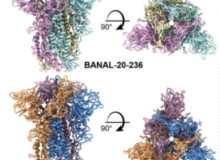by Jonathan Latham and Allison Wilson
How should a regulatory agency announce they have discovered something potentially very important about the safety of products they have been approving for over twenty years?
In the course of analysis to identify potential allergens in GMO crops, the European Food Safety Authority (EFSA) has belatedly discovered that the most common genetic regulatory sequence in commercial GMOs also encodes a significant fragment of a viral gene (Podevin and du Jardin 2012). This finding has serious ramifications for crop biotechnology and its regulation, but possibly even greater ones for consumers and farmers. This is because there are clear indications that this viral gene (called Gene VI) might not be safe for human consumption. It also may disturb the normal functioning of crops, including their natural pest resistance.
What Podevin and du Jardin discovered is that of the 86 different transgenic events (unique insertions of foreign DNA) commercialized to-date in the United States 54 contain portions of Gene VI within them. They include any with a widely used gene regulatory sequence called the CaMV 35S promoter (from the cauliflower mosaic virus; CaMV). Among the affected transgenic events are some of the most widely grown GMOs, including Roundup Ready soybeans (40-3-2) and MON810 maize. They include the controversial NK603 maize recently reported as causing tumors in rats (Seralini et al. 2012).
The researchers themselves concluded that the presence of segments of Gene VI “might result in unintended phenotypic changes”. They reached this conclusion because similar fragments of Gene VI have already been shown to be active on their own (e.g. De Tapia et al. 1993). In other words, the EFSA researchers were unable to rule out a hazard to public health or the environment.
In general, viral genes expressed in plants raise both agronomic and human health concerns (reviewed in Latham and Wilson 2008). This is because many viral genes function to disable their host in order to facilitate pathogen invasion. Often, this is achieved by incapacitating specific anti-pathogen defenses. Incorporating such genes could clearly lead to undesirable and unexpected outcomes in agriculture. Furthermore, viruses that infect plants are often not that different from viruses that infect humans. For example, sometimes the genes of human and plant viruses are interchangeable, while on other occasions inserting plant viral fragments as transgenes has caused the genetically altered plant to become susceptible to an animal virus (Dasgupta et al. 2001). Thus, in various ways, inserting viral genes accidentally into crop plants and the food supply confers a significant potential for harm.
The Choices for Regulators
The original discovery by Podevin and du Jardin (at EFSA) of Gene VI in commercial GMO crops must have presented regulators with sharply divergent procedural alternatives. They could 1) recall all CaMV Gene VI-containing crops (in Europe that would mean revoking importation and planting approvals) or, 2) undertake a retrospective risk assessment of the CaMV promoter and its Gene VI sequences and hope to give it a clean bill of health.
It is easy to see the attraction for EFSA of option two. Recall would be a massive political and financial decision and would also be a huge embarrassment to the regulators themselves. It would leave very few GMO crops on the market and might even mean the end of crop biotechnology.
Regulators, in principle at least, also have a third option to gauge the seriousness of any potential GMO hazard. GMO monitoring, which is required by EU regulations, ought to allow them to find out if deaths, illnesses, or crop failures have been reported by farmers or health officials and can be correlated with the Gene VI sequence. Unfortunately, this particular avenue of enquiry is a scientific dead end. Not one country has carried through on promises to officially and scientifically monitor any hazardous consequences of GMOs (1).
Unsurprisingly, EFSA chose option two. However, their investigation resulted only in the vague and unreassuring conclusion that Gene VI “might result in unintended phenotypic changes” (Podevin and du Jardin 2012). This means literally, that changes of an unknown number, nature, or magnitude may (or may not) occur. It falls well short of the solid scientific reassurance of public safety needed to explain why EFSA has not ordered a recall.
Can the presence of a fragment of virus DNA really be that significant? Below is an independent analysis of Gene VI and its known properties and their safety implications. This analysis clearly illustrates the regulators’ dilemma.
The Many Functions of Gene VI
Gene VI, like most plant viral genes, produces a protein that is multifunctional. It has four (so far) known roles in the viral infection cycle. The first is to participate in the assembly of virus particles. There is no current data to suggest this function has any implications for biosafety. The second known function is to suppress anti-pathogen defenses by inhibiting a general cellular system called RNA silencing (Haas et al. 2008). Thirdly, Gene VI has the highly unusual function of transactivating (described below) the long RNA (the 35S RNA) produced by CaMV (Park et al. 2001). Fourthly, unconnected to these other mechanisms, Gene VI has very recently been shown to make plants highly susceptible to a bacterial pathogen (Love et al. 2012). Gene VI does this by interfering with a common anti-pathogen defense mechanism possessed by plants. These latter three functions of Gene VI (and their risk implications) are explained further below:
1) Gene VI Is an Inhibitor of RNA Silencing
RNA silencing is a mechanism for the control of gene expression at the level of RNA abundance (Bartel 2004). It is also an important antiviral defense mechanism in both plants and animals, and therefore most viruses have evolved genes (like Gene VI) that disable it (Dunoyer and Voinnet 2006).
This attribute of Gene VI raises two obvious biosafety concerns: 1) Gene VI will lead to aberrant gene expression in GMO crop plants, with unknown consequences and, 2) Gene VI will interfere with the ability of plants to defend themselves against viral pathogens. There are numerous experiments showing that, in general, viral proteins that disable gene silencing enhance infection by a wide spectrum of viruses (Latham and Wilson 2008).
2) Gene VI Is a Unique Transactivator of Gene Expression
Multicellular organisms make proteins by a mechanism in which only one protein is produced by each passage of a ribosome along a messenger RNA (mRNA). Once that protein is completed the ribosome dissociates from the mRNA. However, in a CaMV-infected plant cell, or as a transgene, Gene VI intervenes in this process and directs the ribosome to get back on an mRNA (reinitiate) and produce the next protein in line on the mRNA, if there is one. This property of Gene VI enables Cauliflower Mosaic Virus to produce multiple proteins from a single long RNA (the 35S RNA). Importantly, this function of Gene VI (which is called transactivation) is not limited to the 35S RNA. Gene VI seems able to transactivate any cellular mRNA (Futterer and Hohn 1991; Ryabova et al. 2002). There are likely to be thousands of mRNA molecules having a short or long protein coding sequence following the primary one. These secondary coding sequences could be expressed in cells where Gene VI is expressed. The result will presumably be production of numerous random proteins within cells. The biosafety implications of this are difficult to assess. These proteins could be allergens, plant or human toxins, or they could be harmless. Moreover, the answer will differ for each commercial crop species into which Gene VI has been inserted.
3) Gene VI Interferes with Host Defenses
A very recent finding, not known by Podevin and du Jardin, is that Gene VI has a second mechanism by which it interferes with plant anti-pathogen defenses (Love et al. 2012). It is too early to be sure about the mechanistic details, but the result is to make plants carrying Gene VI more susceptible to certain pathogens, and less susceptible to others. Obviously, this could impact farmers, however the discovery of an entirely new function for gene VI while EFSA’s paper was in press, also makes clear that a full appraisal of all the likely effects of Gene VI is not currently achievable.
Is There a Direct Human Toxicity Issue?
When Gene VI is intentionally expressed in transgenic plants, it causes them to become chlorotic (yellow), to have growth deformities, and to have reduced fertility in a dose-dependent manner (Ziljstra et al 1996). Plants expressing Gene VI also show gene expression abnormalities. These results indicate that, not unexpectedly given its known functions, the protein produced by Gene VI is functioning as a toxin and is harmful to plants (Takahashi et al 1989). Since the known targets of Gene VI activity (ribosomes and gene silencing) are also found in human cells, a reasonable concern is that the protein produced by Gene VI might be a human toxin. This is a question that can only be answered by future experiments.
Is Gene VI Protein Produced in GMO Crops?
Given that expression of Gene VI is likely to cause harm, a crucial issue is whether the actual inserted transgene sequences found in commercial GMO crops will produce any functional protein from the fragment of Gene VI present within the CaMV sequence.
There are two aspects to this question. One is the length of Gene VI accidentally introduced by developers. This appears to vary but most of the 54 approved transgenes contain the same 528 base pairs of the CaMV 35S promoter sequence. This corresponds to approximately the final third of Gene VI. Deleted fragments of Gene VI are active when expressed in plant cells and functions of Gene VI are believed to reside in this final third. Therefore, there is clear potential for unintended effects if this fragment is expressed (e.g. De Tapia et al. 1993; Ryabova et al. 2002; Kobayashi and Hohn 2003).
The second aspect of this question is what quantity of Gene VI could be produced in GMO crops? Once again, this can ultimately only be resolved by direct quantitative experiments. Nevertheless, we can theorize that the amount of Gene VI produced will be specific to each independent insertion event. This is because significant Gene VI expression probably would require specific sequences (such as the presence of a gene promoter and an ATG [a protein start codon]) to precede it and so is likely to be heavily dependent on variables such as the details of the inserted transgenic DNA and where in the plant genome the transgene inserted.
Commercial transgenic crop varieties can also contain superfluous copies of the transgene, including those that are incomplete or rearranged (Wilson et al 2006). These could be important additional sources of Gene VI protein. The decision of regulators to allow such multiple and complex insertion events was always highly questionable, but the realization that the CaMV 35S promoter contains Gene VI sequences provides yet another reason to believe that complex insertion events increase the likelihood of a biosafety problem.
Even direct quantitative measurements of Gene VI protein in individual crop authorizations would not fully resolve the scientific questions, however. No-one knows, for example, what quantity, location or timing of protein production would be of significance for risk assessment, and so answers necessary to perform science-based risk assessment are unlikely to emerge soon.
Big Lessons for Biotechnology
It is perhaps the most basic assumption in all of risk assessment that the developer of a new product provides regulators with accurate information about what is being assessed. Perhaps the next most basic assumption is that regulators independently verify this information. We now know, however, that for over twenty years neither of those simple expectations have been met. Major public universities, biotech multinationals, and government regulators everywhere, seemingly did not appreciate the relatively simple possibility that the DNA constructs they were responsible for encoded a viral gene.
This lapse occurred despite the fact that Gene VI was not truly hidden; the relevant information on the existence of Gene VI has been freely available in the scientific literature since well before the first biotech approval (Franck et al 1980). We ourselves have offered specific warnings that viral sequences could contain unsuspected genes (Latham and Wilson 2008). The inability of risk assessment processes to incorporate longstanding and repeated scientific findings is every bit as worrysome as the failure to intellectually anticipate the possibility of overlapping genes when manipulating viral sequences.
This sense of a generic failure is reinforced by the fact that this is not an isolated event. There exist other examples of commercially approved viral sequences having overlapping genes that were never subjected to risk assessment. These include numerous commercial GMOs containing promoter regions of the closely related virus figwort mosaic virus (FMV) which were not considered by Podevin and du Jardin. Inspection of commercial sequence data shows that the commonly used FMV promoter overlaps its own Gene VI (Richins et al 1987). A third example is the virus-resistant potato NewLeaf Plus (RBMT-22-82). This transgene contains approximately 90% of the P0 gene of potato leaf roll virus. The known function of this gene, whose existence was discovered only after US approval, is to inhibit the anti-pathogen defenses of its host (Pfeffer et al 2002). Fortunately, this potato variety was never actively marketed.
A further key point relates to the biotech industry and their campaign to secure public approval and a permissive regulatory environment. This has led them to repeatedly claim, firstly, that GMO technology is precise and predictable; and secondly, that their own competence and self-interest would prevent them from ever bringing potentially harmful products to the market; and thirdly, to assert that only well studied and fully understood transgenes are commercialized. It is hard to imagine a finding more damaging to these claims than the revelations surrounding Gene VI.
Biotechnology, it is often forgotten, is not just a technology. It is an experiment in the proposition that human institutions can perform adequate risk assessments on novel living organisms. Rather than treat that question as primarily a daunting scientific one, we should for now consider that the primary obstacle will be overcoming the much more mundane trap of human complacency and incompetence. We are not there yet, and therefore this incident will serve to reinforce the demands for GMO labeling in places where it is absent.
What Regulators Should Do Now
This summary of the scientific risk issues shows that a segment of a poorly characterized viral gene never subjected to any risk assessment (until now) was allowed onto the market. This gene is currently present in commercial crops and growing on a large scale. It is also widespread in the food supply.
Even now that EFSA’s own researchers have belatedly considered the risk issues, no one can say whether the public has been harmed, though harm appears a clear scientific possibility. Considered from the perspective of professional and scientific risk assessment, this situation represents a complete and catastrophic system failure.
But the saga of Gene VI is not yet over. There is no certainty that further scientific analysis will resolve the remaining uncertainties, or provide reassurance. Future research may in fact increase the level of concern or uncertainty, and this is a possibility that regulators should weigh heavily in their deliberations.
To return to the original choices before EFSA, these were either to recall all CaMV 35S promoter-containing GMOs, or to perform a retrospective risk assessment. This retrospective risk assessment has now been carried out and the data clearly indicate a potential for significant harm. The only course of action consistent with protecting the public and respecting the science is for EFSA, and other jurisdictions, to order a total recall. This recall should also include GMOs containing the FMV promoter and its own overlapping Gene VI.
Footnotes
1) EFSA regulators might now be regretting their failure to implement meaningful GMO monitoring. It would be a good question for European politicians to ask EFSA and for the board of EFSA to ask the GMO panel, whose job it is to implement monitoring.
References
Bartel P (2004) MicroRNAs: Genomics, Biogenesis, Mechanism, and Function. Cell: 116, 281-297.
Dasgupta R , Garcia BH, Goodman RM (2001) Systemic spread of an RNA insect virus in plants expressing plant viral movement protein genes. Proc. Natl. Acad. Sci. USA 98: 4910-4915.
De Tapia M, Himmelbach A, and Hohn T (1993) Molecular dissection of the cauliflower mosaic virus translation transactivator. EMBO J 12: 3305-14.
Dunoyer P, and O Voinnet (2006) The complex interplay between plant viruses and host RNA-silencing pathways. Curr Opinion in Plant Biology 8: 415–423.
Franck A, H Guilley, G Jonard, K Richards and L Hirth (1980) Nucleotide sequence of cauliflower mosaic virus DNA. Cell 2: 285-294.
Futterer J, and T Hohn (1991) Translation of a polycistronic mRNA in presence of the cauliflower mosaic virus transactivator protein. EMBO J. 10: 3887-3896.
Haas G, Azevedo J, Moissiard G, Geldreich A, Himber C, Bureau M, et al. (2008) Nuclear import of CaMV P6 is required for infection and suppression of the RNA silencing factor DRB4. EMBO J 27: 2102-12.
Kobayashi K, and T Hohn (2003) Dissection of Cauliflower Mosaic Virus Transactivator/Viroplasmin Reveals Distinct Essential Functions in Basic Virus Replication. J. Virol. 77: 8577–8583.
Latham JR, and AK Wilson (2008) Transcomplementation and Synergism in Plants: Implications for Viral Transgenes? Molecular Plant Pathology 9: 85-103.
Park H-S, Himmelbach A, Browning KS, Hohn T, and Ryabova LA (2001). A plant viral ‘‘reinitiation’’ factor interacts with the host translational machinery. Cell 106: 723–733.
Pfeffer S, P Dunoyer, F Heim, KE Richards, G Jonard, V Ziegler-Graff (2002) P0 of Beet Western Yellows Virus Is a Suppressor of Posttranscriptional Gene Silencing. J. Virol. 76: 6815–6824.
Podevin N and du Jardin P (2012) Possible consequences of the overlap between the CaMV 35S promoter regions in plant transformation vectors used and the viral gene VI in transgenic plants. GM Crops and Food 3: 1-5.
Love AJ , C Geri, J Laird, C Carr, BW Yun, GJ Loake et al (2012) Cauliflower mosaic virus Protein P6 Inhibits Signaling Responses to Salicylic Acid and Regulates Innate Immunity. PLoS One. 7(10): e47535.
Richins R, H Scholthof, RJ Shepherd (1987) Sequence of figwort mosaic virus DNA (caulimovirus group). NAR 15: 8451-8466.
Ryabova LA , Pooggin, MH and Hohn, T (2002) Viral strategies of translation initiation: Ribosomal shunt and reinitiation. Progress in Nucleic Acid Research and Molecular Biology 72: 1-39.
Séralini, G-E., E. Clair, R. Mesnage, S. Gress, N. Defarge, M. Malatesta, D. Hennequin, J. Spiroux de Vendômois. 2012. Long term toxicity of a Roundup herbicide and a Roundup-tolerant genetically modified maize. Food Chem. Toxicol.
Takahashi H, K Shimamoto, Y Ehara (1989) Cauliflower mosaic virus gene VI causes growth suppression, development of necrotic spots and expression of defence-related genes in transgenic tobacco plants. Molecular and General Genetics 216:188-194.
Wilson AK, JR Latham and RA Steinbrecher (2006) Transformation-induced mutations in transgenic plants: Analysis and biosafety implications. Biotechnology and Genetic Engineering Reviews 23: 209-234.
Zijlstra C, Schärer-Hernández N, Gal S, Hohn T. Arabidopsis thaliana expressing the cauliflower mosaic virus ORF VI transgene has a late flowering phenotype. Virus Genes 1996; 13:5-17.
















